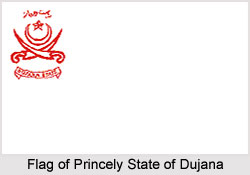 The Princely State of Dujana, also known as Dujaana, was one of the native states of India during the rule of the British Empire in India. During the 19th century, the territory was appointed as one of the princely states of India under the indirect rule of the British Government. The state covered a total area of 91 sq miles and consisted of a total population of 30,666 in the year 1941. The former native state of Dujana was comprised of 2 small tracts, namely Dujana proper and Mohrana. Dujana proper was located towards the west of Delhi and was little bigger than the town of Dujana. Mohrana was the larger district and was bounded by the British district of Gurgaon in the south; and by the British district of Rohtak in the northeast (both the regions belonged to the Ambala Division of the Province of Punjab). The territory was bordered by a block of Jind territory (Dadri) in the north; and by a block of Nabha territory (Bawal) in the west.
The Princely State of Dujana, also known as Dujaana, was one of the native states of India during the rule of the British Empire in India. During the 19th century, the territory was appointed as one of the princely states of India under the indirect rule of the British Government. The state covered a total area of 91 sq miles and consisted of a total population of 30,666 in the year 1941. The former native state of Dujana was comprised of 2 small tracts, namely Dujana proper and Mohrana. Dujana proper was located towards the west of Delhi and was little bigger than the town of Dujana. Mohrana was the larger district and was bounded by the British district of Gurgaon in the south; and by the British district of Rohtak in the northeast (both the regions belonged to the Ambala Division of the Province of Punjab). The territory was bordered by a block of Jind territory (Dadri) in the north; and by a block of Nabha territory (Bawal) in the west.
The princely state of Dujana also held some distinct villages in Gurgaon, the small tract of Nahar and a part of Jhaul towards the south of Jhajjar. Dujana state included 30 villages and one town in the year 1911. The Princely State of Dujana was under the administrative and political control of the Punjab States Agency.
History of Princely State of Dujana
The native rulers of the state of Dujana belonged to an Afghan family of Yusufzai Pathans. The family was founded during the 14th century. Abdas Samad Khan was the first family member of note who was granted the title of Nawab in the year 1806. Moreover vast hereditary estates by the British East India Company were rendered against Holkar for military service. His terriotory included the whole western region of the Rohtak district, as well as all of the area held by George Thomas in Hissar. He properly dealt with the task of managing them without the support of the British administration. But in the year 1809, it was exchanged for the smaller tracts of Dujana and Mehrana.
The native ruler of the princely state of Dujana held the title of Nawab and he was charged with the administration and management of the erstwhile Indian princely state. Dujana state was ranked 19th amongst the Punjab states. The Nawab of Dujana also exercised civil and criminal jurisdiction, excluding authority over capital cases which involved his own subjects. The state of Dujana was segregated into the 2 tahsils of Nahar and Dujana. The princely state of Dujana was one of the original constituent members of the Chamber of Princes, a number of smaller states indirectly represented by 12 princes whom they elected periodically.
On March 3, 1948, the last native ruler of Dujana state, who was the 7th of his line, acceded the princely state to the Dominion of India, also known as Union of India, after the country gained independence from the British supremacy in the year 1947. At present, Dujana is located in the Indian state of Haryana.



















